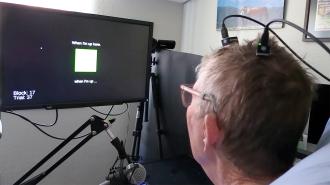Stanford researchers have developed a speech brain-computer interface (BCI) they say can translate thoughts into text at a record-breaking speed — putting us closer to a future in which people who can’t talk can still easily communicate.
The challenge: “Anarthria” is a devastating condition in which a person can’t speak, despite being able to understand speech and knowing what they want to say. It’s usually caused by a brain injury, such as a stroke, or a neurological disorder, such as Parkinson’s disease or ALS.
Some people with anarthria write or use eye-tracking tech to communicate, but this “speech” is far slower than the average talking speed. People with anarthria due to total paralysis or locked-in syndrome can’t even move their eyes, though, leaving them with no way to communicate.
The goal is to develop speech BCIs that allow people to “talk” at the rate at which people without impairments speak.
Thought-to-text: Speech BCIs have the potential to give people with anarthria back their voices.
These devices translate people’s brain activity (usually picked up via implanted electrode arrays) into commands for computers. With proper training, they can translate a person’s thoughts into text on a screen.
In past studies, researchers have trained BCIs by asking people to think about adjusting the pitch of an audible tone or using a pen to handwrite individual letters.
While a totally paralyzed man was only able to choose about one character per minute using the tone system, a person with limb paralysis was able to write at a speed of 18 words per minute using the handwriting-based BCI, setting a world record.
Electrodes recorded the woman’s brain activity while she tried saying phonemes, whole words, or entire sentences.
What’s new? While the ability to communicate slowly is better than not at all, the goal is to develop speech BCIs that allow people to “talk” as close as possible to the rate at which people without impairments speak: around 160 words per minute.
We’re now a huge step closer to that goal, according to a draft paper Stanford researchers have shared on the preprint server bioRXiv.
They describe how a person who could no longer speak intelligibly due to ALS was able to communicate at a speed of 62 words per minute, using their in-development speech BCI — more than three times faster than the previous record.
How it works: Rather than asking their study participant, known as “subject T12,” to think about moving her hand or adjusting a tone to produce words, the Stanford researchers asked her to try actually talking.
Over the course of about four months, implanted electrodes recorded the woman’s brain activity while she tried saying phonemes, whole words, or entire sentences shown on a computer screen. This training took place in 2-4 hours sessions about twice a week.
Once they had their training data, correlating brain signals and words, the researchers implemented a word prediction system to increase the accuracy of their speech BCI — this way, if it was trying to decide between multiple words, it would choose the word more likely to follow its predecessors in the context.
“The performance in this paper is already at a level which many people who cannot speak would want.”
Philip Sabes
A new record: To test the system, the woman attempted to say sentences that hadn’t been included in the training set, and the BCI was able to predict her speech at an average speed of 62 words per minute.
When the sentences were constructed using a library of 50 words, the error rate was 9.1%. The previous state-of-the-art BCI designed to translate attempts at speaking into text had a median error rate of 25% on that same library — and a speed of just 18 words per minute.
“The performance in this paper is already at a level which many people who cannot speak would want, if the device were ready,” Philip Sabes, a BCI researcher at UC San Francisco, who was not involved in this study, told MIT Technology Review. “People are going to want this.”
The big picture: The error rate for Standford’s speech BCI was much higher — 23.8% — when the test sentences were constructed using a library of 125,000 words, so the accuracy would need to be improved to give people with anarthria the freedom to say anything.
Even if researchers are able to perfect the software, though, speech BCIs are still extremely experimental, and there are other issues to overcome — over time, scar tissue forms around traditional electrode implants, eventually rendering them useless.
Still, if the Stanford study holds up under peer-review, it represents a major step forward for speech BCIs — putting us closer to a future in which people with anarthria are able to communicate effectively using just their thoughts.
We’d love to hear from you! If you have a comment about this article or if you have a tip for a future Freethink story, please email us at tips@freethink.com.
